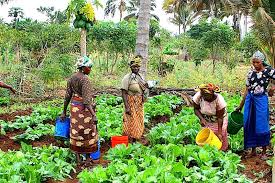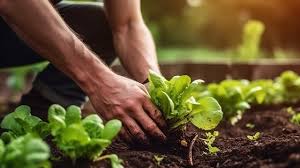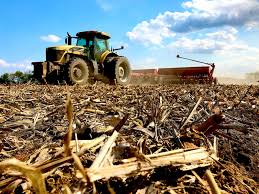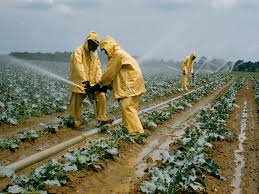Agriculture has both positive and negative effects on the environment. While it provides food, fiber, and raw materials for industries, it also contributes to environmental issues such as deforestation, soil degradation, water scarcity, and biodiversity loss.
1. Soil Degradation: Intensive farming practices, such as overuse of chemical fertilizers and pesticides, can deplete soil nutrients and lead to soil erosion. This reduces the land’s productivity over time.
2. Water Pollution: Agriculture is one of the largest users of freshwater. Excessive irrigation, along with the use of fertilizers and pesticides, can pollute rivers, lakes, and groundwater sources, affecting both human and aquatic life.
3. Greenhouse Gas Emissions: Agriculture contributes to climate change by releasing greenhouse gases like methane from livestock and nitrous oxide from fertilizer use. These gases contribute to global warming and climate instability.
4. Deforestation: Clearing forests to create farmland is a major driver of deforestation, especially in tropical regions. This leads to habitat loss for many species and reduces the Earth’s capacity to absorb carbon dioxide.
5. Biodiversity Loss: The expansion of monoculture farming (growing a single crop over a large area) reduces biodiversity by displacing native plants and animals. This makes ecosystems more vulnerable to pests and diseases.
Agriculture and Global Trade
Global trade in agricultural products plays a significant role in the economy of many countries, particularly developing nations. Agriculture’s contribution to trade is crucial for food security, income generation, and economic growth.
1. Export of Agricultural Products: Many countries, especially developing ones, rely on agriculture as a key export sector. Crops like coffee, tea, cocoa, cotton, and sugar are major exports that generate revenue for countries involved in global trade.
2. Trade Agreements: Trade agreements between countries help facilitate the flow of agricultural goods across borders. These agreements can open up new markets for farmers, allowing them to sell their products globally.
3. Impact on Food Security: Global trade ensures that food can be distributed to regions where it’s most needed. Countries that experience food shortages due to climate change or other factors can import food to meet their needs.
4. Price Volatility: International trade can sometimes lead to price volatility. Global demand, currency fluctuations, and geopolitical tensions can affect the price of agricultural products, impacting both farmers and consumers.
5. Trade Barriers: Tariffs, quotas, and other trade restrictions can affect the competitiveness of agricultural products in the global market. These barriers can make it difficult for farmers to access new markets and reduce their income.
Role of Agriculture in National Security

Agriculture is a key factor in national security because it ensures food security, promotes economic stability, and supports the well-being of the population.
1. Food Security: A reliable agricultural sector ensures that a country can produce enough food to feed its population. Without sufficient food production, countries may become vulnerable to food shortages, leading to social unrest.
2. Economic Stability: Agriculture is often a major sector of the economy, particularly in developing countries. A stable agricultural sector provides jobs, income, and supports rural economies, contributing to national economic stability.
3. Rural Development: Agriculture helps develop rural areas by providing employment, infrastructure, and access to education and healthcare. Strong rural communities are less likely to experience poverty and instability, which can affect national security.
4. Energy Security: Agriculture also plays a role in energy security by producing biofuels such as ethanol and biodiesel. These renewable energy sources help reduce reliance on imported fossil fuels.
5. Disaster Resilience: A strong agricultural sector helps countries recover from natural disasters and other emergencies. Food reserves, robust farming practices, and local food production reduce dependency on external aid.
Innovations and Technology in Agriculture
Advances in technology are transforming agriculture, making it more efficient, productive, and sustainable. Innovations in agricultural technology help farmers optimize their operations, reduce costs, and increase yields.
1. Precision Farming: Precision farming uses data analytics, GPS, and satellite imagery to monitor crops and make more informed decisions about planting, irrigation, and fertilization. This technology helps farmers reduce waste and improve yields.
2. Drones and Sensors: Drones and sensors are used to monitor crop health, soil moisture, and pest infestations. These technologies allow farmers to take targeted actions, such as applying water or pesticides only where needed.
3. Genetic Engineering: Advances in genetic engineering have led to the development of crops that are resistant to pests, diseases, and drought. Genetically modified organisms (GMOs) can increase crop yields and reduce the need for chemical inputs.
4. Automation: Robots and automated machinery are increasingly used for planting, harvesting, and packaging crops. Automation reduces labor costs and allows farmers to manage larger farms more efficiently.
5. Artificial Intelligence (AI): AI is being used in agriculture to analyze large amounts of data, predict crop yields, and optimize farm operations. AI-powered systems help farmers make better decisions and improve productivity.
Read Also: 5 Amazing Health Benefits of Triphala (Three fruits)
Sustainable Agriculture Practices

Sustainable agriculture aims to meet current food needs without compromising the ability of future generations to meet their own needs. Sustainable farming practices focus on environmental health, economic profitability, and social equity.
1. Crop Rotation: Crop rotation involves growing different crops in the same field in a planned sequence. This practice helps improve soil health, reduce pests and diseases, and increase crop yields.
2. Organic Farming: Organic farming avoids synthetic chemicals and relies on natural methods to improve soil fertility and control pests. Organic farming practices help maintain biodiversity and reduce environmental damage.
3. Conservation Tillage: Conservation tillage involves reducing the frequency of soil disturbance, which helps prevent soil erosion and improve water retention. This practice also reduces greenhouse gas emissions by keeping carbon in the soil.
4. Agroforestry: Agroforestry integrates trees and shrubs into agricultural landscapes. Trees provide shade, reduce wind erosion, improve water retention, and contribute to biodiversity, all while producing food, fuel, and other products.
5. Water Conservation: Sustainable agriculture uses water efficiently through methods such as drip irrigation, rainwater harvesting, and the use of drought-resistant crop varieties. Water conservation is essential in areas prone to water scarcity.
Agriculture and Climate Change
Climate change poses significant challenges to agriculture, but agriculture also has a role in mitigating its effects. Sustainable farming practices can reduce greenhouse gas emissions and help agriculture adapt to changing weather patterns.
1. Impact on Crop Yields: Climate change affects temperature, rainfall, and the frequency of extreme weather events, all of which impact crop yields. Some regions may experience reduced agricultural productivity, leading to food shortages.
2. Livestock and Climate Change: Livestock farming contributes to methane emissions, a potent greenhouse gas. Sustainable livestock practices, such as improved feed and manure management, can reduce emissions.
3. Carbon Sequestration: Agriculture can help mitigate climate change by capturing carbon in soils through practices like cover cropping, no-till farming, and agroforestry. These practices help reduce the amount of carbon dioxide in the atmosphere.
4. Drought and Water Scarcity: As climate change leads to more frequent droughts, agriculture must adapt by using water more efficiently. Drought-resistant crop varieties, efficient irrigation, and rainwater harvesting are critical to maintaining productivity in dry regions.
5. Reducing Food Waste: Reducing food waste at the farm level and throughout the supply chain helps lower the environmental impact of agriculture. Less food waste means fewer resources are used for food production, reducing the overall carbon footprint of agriculture.
Read Also: Sheep Milk Production Complete Guide
Negative Environmental Impacts of Agriculture

While agriculture is essential for feeding the growing global population, it also has significant negative impacts on the environment. Unsustainable farming practices can lead to soil degradation, water pollution, deforestation, and loss of biodiversity.
Understanding these impacts is crucial for developing better agricultural methods that protect the environment. This section explores the negative environmental impacts of agriculture, focusing on soil degradation and erosion, deforestation, water pollution, greenhouse gas emissions, and the effects of pesticides and fertilizers on ecosystems.
Soil Degradation and Erosion
Soil is a vital resource for agriculture, but many practices contribute to its degradation and erosion.
1. Overgrazing: When livestock graze too much on land, they can remove vegetation that protects the soil. This leads to bare soil that is more susceptible to erosion by wind and water.
2. Intensive Tillage: Conventional farming often involves frequent tilling, which disrupts soil structure and increases erosion. Tilling can also deplete organic matter, reducing soil fertility.
3. Monoculture Practices: Growing a single crop repeatedly can degrade soil health. It leads to nutrient depletion and makes soils more vulnerable to erosion, as the root systems of diverse plants are absent.
4. Loss of Soil Organic Matter: Practices that reduce organic matter, such as overuse of chemical fertilizers, can degrade soil health. Organic matter is essential for maintaining soil structure and fertility.
5. Soil Salinization: Irrigation practices, particularly in arid regions, can lead to the accumulation of salts in the soil. High salt levels can render soil unproductive, impacting agricultural yields.
Deforestation and Habitat Loss
Agriculture is a leading cause of deforestation, which results in habitat loss for countless species.
1. Land Conversion: Large areas of forests are cleared to create farmland. This loss of forests reduces biodiversity and disrupts ecosystems that depend on these habitats.
2. Fragmentation: Agricultural expansion often leads to fragmented landscapes. Isolated patches of habitat make it difficult for wildlife to thrive and migrate, resulting in reduced genetic diversity.
3. Loss of Ecosystem Services: Forests provide essential services like carbon storage, water regulation, and soil protection. Deforestation reduces these services, impacting both the environment and agriculture itself.
4. Increased Soil Erosion: Removing trees and vegetation leads to soil erosion, as there are fewer roots to hold the soil in place. This further degrades land and can contribute to sedimentation in water bodies.
5. Climate Change Contribution: Deforestation releases stored carbon into the atmosphere, contributing to climate change. This exacerbates the negative impacts of agriculture, creating a vicious cycle of environmental degradation.
Water Pollution from Agricultural Runoff
Agricultural activities often lead to water pollution, primarily through runoff that carries harmful substances into water bodies.
1. Nutrient Runoff: Excessive use of fertilizers can result in nutrient runoff, especially nitrogen and phosphorus, into rivers and lakes. This can lead to eutrophication, causing harmful algal blooms that deplete oxygen in the water.
2. Pesticide Contamination: Pesticides used in farming can wash into nearby water sources, harming aquatic life and disrupting ecosystems. These chemicals can accumulate in the food chain, affecting fish and other wildlife.
3. Sedimentation: Erosion from agricultural fields can lead to increased sediment in water bodies. Sediment can smother aquatic habitats and disrupt the growth of plants and organisms that rely on clean water.
4. Pathogen Pollution: Livestock operations can contribute to water pollution through runoff containing pathogens from manure. This contamination poses risks to human health and can affect drinking water sources.
5. Decreased Water Quality: Pollution from agricultural runoff can degrade water quality, making it unsafe for drinking, recreation, and wildlife. This can lead to economic impacts on communities that rely on clean water.
Greenhouse Gas Emissions from Agricultural Practices
Agriculture contributes significantly to greenhouse gas emissions, which drive climate change.
1. Methane Emissions: Livestock, particularly cattle, produce methane during digestion. This potent greenhouse gas has a much greater warming effect than carbon dioxide.
2. Nitrous Oxide Emissions: The use of nitrogen fertilizers leads to the release of nitrous oxide, another powerful greenhouse gas. This occurs when fertilizers break down in the soil.
3. Land Use Change: Converting forests and wetlands into agricultural land releases stored carbon into the atmosphere, contributing to climate change. The loss of these ecosystems means less carbon storage capacity.
4. Energy Use: Agricultural operations, including machinery, transportation, and processing, consume significant amounts of fossil fuels, leading to carbon dioxide emissions.
5. Waste Management: The management of agricultural waste, such as manure, can also produce greenhouse gases. Improper disposal or storage can lead to methane emissions from decomposing organic matter.
Pesticide and Fertilizer Impact on Ecosystems
The use of pesticides and fertilizers in agriculture can have severe consequences for ecosystems.
1. Non-Target Species: Pesticides can kill beneficial insects, such as pollinators and natural pest predators. This disrupts the balance of ecosystems and can lead to increased pest populations.
2. Soil Microbial Life: Chemical fertilizers and pesticides can harm beneficial soil microorganisms that are essential for nutrient cycling and soil health. This impacts soil fertility and plant growth.
3. Water Quality Degradation: As mentioned earlier, pesticide and fertilizer runoff can contaminate water bodies, harming aquatic life and disrupting ecosystems. This leads to the loss of biodiversity in freshwater systems.
4. Resistance Development: Over-reliance on pesticides can lead to the development of resistant pest populations. This results in the need for even stronger chemicals, exacerbating environmental harm.
5. Bioaccumulation: Pesticides can accumulate in the tissues of organisms, leading to toxic effects on wildlife and even humans. This bioaccumulation can have long-term ecological consequences.
The negative environmental impacts of agriculture are significant and far-reaching. Addressing these challenges requires a shift towards sustainable agricultural practices that minimize harm to the environment. By adopting methods that enhance soil health, reduce water pollution, mitigate greenhouse gas emissions, and protect biodiversity, we can create a more sustainable agricultural system.
It is crucial for farmers, policymakers, and consumers to work together to promote practices that support both food production and environmental sustainability. Balancing agricultural needs with environmental protection is essential for the future of our planet..
Do you have any questions, suggestions, or contributions? If so, please feel free to use the comment box below to share your thoughts. We also encourage you to kindly share this information with others who might benefit from it. Since we can’t reach everyone at once, we truly appreciate your help in spreading the word. Thank you so much for your support and for sharing!
Read Also: The Effect of Solid Waste on Business Environments






